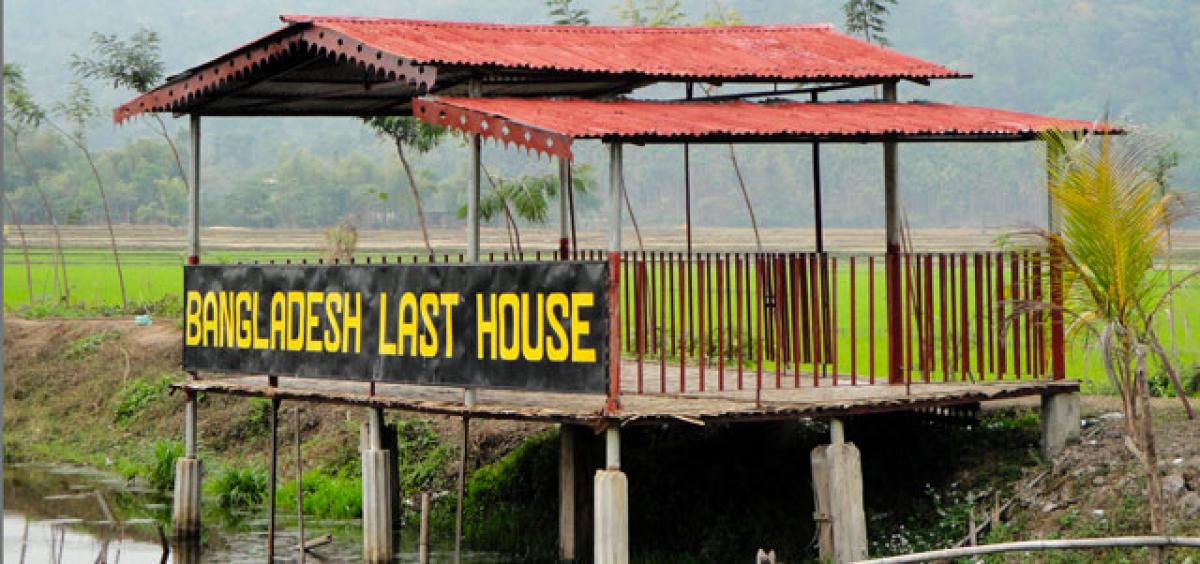Just In

Downpours in the highlands of Meghalaya and damaging floods in the wetlands of north-eastern Bangladesh are inextricably linked. The South Asian neighbours must collaborate to address these occasional calamities “We were in a festive mood just after the celebrations for the Bengali new year.
TRANS-BOUNDARY FLOODS
Downpours in the highlands of Meghalaya and damaging floods in the wetlands of north-eastern Bangladesh are inextricably linked. The South Asian neighbours must collaborate to address these occasional calamities “We were in a festive mood just after the celebrations for the Bengali new year. All preparations were made to harvest our crops but the sudden heavy rainfall and flash flood destroyed everything,” says Shafikul Islam, a farmer from Tahirpur Sadar in Sunamganj district, north-eastern Bangladesh.
Islam’s lament is depressingly familiar in the bowl-shaped wetlands called haors in north-eastern Bangladesh, where thousands of farmers like him lose their crops to severe flooding whenever it rains heavily in the southern reaches of Meghalaya. Known as the wettest region of India, Meghalaya receives, on an average, 120cm of rainfall per year. Whenever it rains there, people living around the haors in Bangladesh are apprehensive.
But this year’s flash flood was different says Istiak Sobhan, environmental specialist at the World Bank in Bangladesh. Usually the region experiences flash floods in mid-May when farmers have already harvested their spring crops. The flash flood caused the water to surge over the embankment, which inundated acre after acre of standing crop in the Dhaki Union of Kishorganj district, Bangladesh.
The valleys of Meghalaya on the north of the ridge bordering Bangladesh do not escape unscathed from the rains. The incessant rains that flooded the haors at the end of April also led to a flash flood in Meghalaya’s south-west Garo Hills district, submerging houses and agricultural land, and causing damage to roads and fish ponds, according to local media reports. In East Garo Hills, residents reported that the Simsang River was flowing close to the danger mark. Other rivers were also in a spate.
Although the damage in Meghalaya was not very high, the loss to haor farmers in Bangladesh has been extensive. In Netrokona district alone, around 73,070 hectares of paddy fields were submerged, according to the Dhaka Tribune. “This paddy would have produced at least 281,320 tonnes of rice, the current market value of which is nearly BDT 956.49 crore (US$ 1.2 million),” according to Bilash Chandra Pal, the Netrokona district agricultural officer.
The early flash flood also destroyed the spring Boro rice crop in more than 200,000 hectares of haor land in the Sunamganj, Sylhet, Moulvibazar, Netrokona and Kishoreganj districts. Boro is the major paddy crop in Bangladesh, accounting for 19 of 34 million tonnes of annual production in the country, according to the Department of Agriculture Extension. The damage to two million tonnes of rice will cause the country to suffer for the rest of the year, and its impact has already been noticed following a hike in the prices of staple foods in the market, says agricultural economist, Quazi Shahabuddin.
The Bangladesh government is planning to buy 600,000 tons of rice from international markets, including India and Thailand. In addition to the loss of a good harvest, farmers and fishermen in the affected region complained of fish dying due to water contamination. At least 300,000 farmers were severely affected, which also created an acute shortage of fodder, forcing distress sales of farm animals. Farmers in Gopedighi union of Kishorganj, Bangladesh, are facing a tough time as most crops have been destroyed by flash flood triggered by incessant rain and onrush of water from the upstream.
Duck farming is one of the major sources of livelihood in the haor region, but birds are dying due to the toxic gases and polluted water from rotten rice. People are leaving their homes and are forecasting a severe crisis of food and lack of livelihood in the area. The government has already banned fishing in a number of haors, which is a wetland ecosystem recognised by the Ramsar Convention.
Towards the end of March, the rainfall in Sylhet, which is south of Meghalaya and across the border, was four times more than in the same days last year, according to the Bangladesh Meteorological Department. Rainfall was above normal from March 1 to May 10 this year in the north-east region of India, according to India Meteorological Department.
Although the role of climate change in flash floods such as these is yet to be firmly established, pre-monsoon rainfall and its intensity may increase in the future, according to a recent study by the Bangladesh University of Engineering and Technology (BUET) (Courtesy: https://www.thethirdpole.net/)
By Zr Soeb/Soumya Sarkar

© 2024 Hyderabad Media House Limited/The Hans India. All rights reserved. Powered by hocalwire.com







